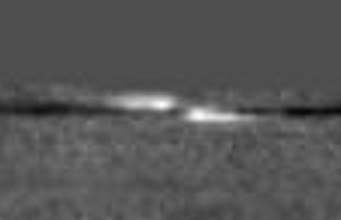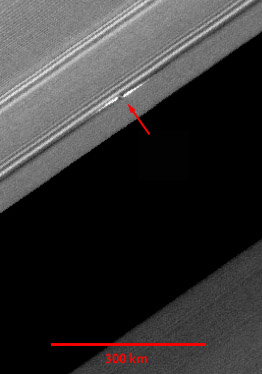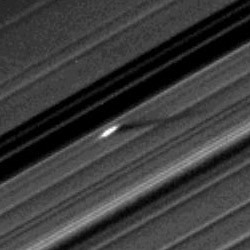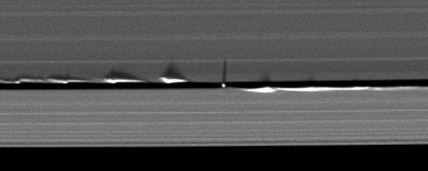Future space historians will recall two great epochs of discovery concerning Saturn's rings.
In the first, circa 1980, Voyager 1 discovered that the planet's stunning ring system is not a single smooth sheet but rather thousands of interconnected ribbons, at once beautiful and strange in their collective organization. In the second, circa 2005-10, the Cassini orbiter found the rings to be even more beautiful — and stranger — than we'd previously imagined.

The largest "propeller" yet found in Saturn's A ring, nicknamed Blériot, sports a pair of bright "blades" about 70 miles (110 km) long. This feature probably results from a tiny, unseen moonlet about 0.5 mile (1 km) across. Click here to see the entire image.
NASA / JPL / Space Science Inst.
Take, for example, mysterious twists of icy rubble dubbed "propellers" because of their distinctive shape. Cassini's cameras have spotted thousands of them in three narrow zones within the A ring, the outermost of the planet's main bands. Predicted to exist even before the craft's arrival, they're apparently caused by tiny moonlets embedded within the ring — too small to be resolved in images, but massive enough to disturb the flow of particles in their vicinity.
Cornell researcher Matthew Tiscareno (a.k.a. "Propeller Man") has intently followed these curious features since their discovery by Cassini in 2006. He's concluded that the twin "blades" appear to be voids with relatively few ring particles or regions of close-packed particles, either of which can look bright against the background ring. His best-guess estimates suggest that the embedded moonlets have to be at least 1,000 feet (300 m) across to make themselves known.

The large propeller nicknamed Earhart is located in Saturn's A ring just outside the Encke Gap (wide dark band).
NASA / JPL / Space Science Inst.
Until recently, the propellers were thought to be furtive, now-you-see-'em-now-you-don't features created in the dense pancake of ring particles surrounding Saturn. But recent work by Tiscareno and others, just published in Astrophysical Journal Letters, has turned up a family of relatively large ones — some of them thousands of miles long — that Cassini has been able to track for up to 4 years.
These bigger specimens lie farther from Saturn than their smaller siblings, in a 2,000-mile-wide strip between the Encke Gap and the A ring's outer edge. To help tell them apart, Tiscareno has given 11 of them nicknames that honor early aviators (Lindbergh, Earhart, Sikorsky, Richthofen, and so on). The one dubbed Blériot after French aviation pioneer Louis Blériot, appears in more than 100 Cassini images and was even observed by the spacecraft during a stellar occultation.
The long string of observations shows that Blériot hasn't always turned up where expected: it sometimes precedes or lags its expected position by hundreds of miles. Either the responsible moonlet is being swayed by some unidentified resonance with another, larger moon, or it's being bumped and jostled as it circles Saturn.

Another view of the "propeller" dubbed Earhart, taken a couple days after the planet”™s August 2009 equinox, reveals a long shadow cast by a bright segment of disturbed ring material that's 80 miles (130 km).
NASA / JPL / Space Science Inst.
This lack of consistency makes it more difficult to predict the long-term future of the largest propellers. In principle, their central bodies should be tidally interacting with Saturn's ring system in a way that gradually pushes them outward. Eventually they should escape the main ring altogether — that's apparently what happened to Atlas, the flying-saucer moonlet that skirts along the A ring's outer edge.
"The fact that we do not see consistent outward migration in Bleriot's orbit suggests that a different mechanism must be operating in that case," observes Tiscareno. Maybe the greatest gravitational influence comes from ring material that is close by, he says, leading to migration that's sometimes outward and sometimes inward.
In any case, the existence of dozens of embedded moonlets as large as a mile across (and a few larger ones like Pan and Daphnis, which have created clearings within the disk) has an important implication for the origin of Saturn's ring system as a whole. If these turn out to be solid objects and not just compacted "dust kitties" of ring particles, then they are too large to have formed in place billions of years ago. (Saturn's powerful gravity would have kept such a primordial ring stirred up and unable to form such sizable moonlets.)

Only about 5 miles (8 km) across, the tiny moonlet Daphnis still has enough mass to create a clearing in Saturn's A ring (called the Keeler Gap) and to create ridges of disturbed ring material up to 1 mile (1½ km) high. Both the moon and the ridges cast shadows in this view taken near Saturn's August 2009 equinox.
NASA / JPL / Space Science Inst.
Instead, the ring system would have most likely formed from the breakup of a long-ago satellite — either through tidal disruption or an outright collision — that was the size and mass of the Saturnian moon Mimas, about 250 miles (400 km) across. Many ring specialists favor this idea, but they can't yet agree whether it happened billions of years ago or in the geologically recent past, say, within the past 100 million years.
Fortunately, assuming it continues to operate well, Cassini has a green light from NASA to operate until 2017. This should give Tiscareno and other ring specialists enough time to unravel the propellers' mysteries — and much, much more.
 1
1
Comments
Don
July 17, 2010 at 6:31 am
Fascinating article. I would think studying all the interesting physics of Saturn's rings could help us understand related things like the formation of planetary systems around stars. I remember back in the Voyager program when the "spokes" were discovered. There was some speculation that electromagnetic, not gravitational, effects were involved there. Has any more been figured out since then by the Cassini mission?
You must be logged in to post a comment.
You must be logged in to post a comment.